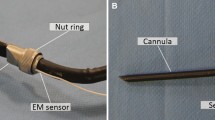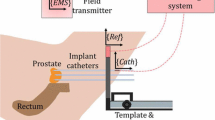Abstract
Purpose
Electromagnetic tracking is a core platform technology in the navigation and visualisation of image-guided procedures. The technology provides high tracking accuracy in non-line-of-sight environments, allowing instrument navigation in locations where optical tracking is not feasible. EMT can be beneficial in applications such as percutaneous radiofrequency ablation for the treatment of hepatic lesions where the needle tip may be obscured due to difficult liver environments (e.g subcutaneous fat or ablation artefacts). Advances in the field of EMT include novel methods of improving tracking system accuracy, precision and error compensation capabilities, though such system-level improvements cannot be readily incorporated in current therapy applications due to the ‘blackbox’ nature of commercial tracking solving algorithms.
Methods
This paper defines a software framework to allow novel EMT designs, and improvements become part of the global design process for image-guided interventions. An exemplary framework is implemented in the Python programming language and demonstrated with the open-source Anser EMT system. The framework is applied in the preclinical setting though targeted liver ablation therapy on an animal model.
Results
The developed framework was tested with the Anser EMT electromagnetic tracking platform. Liver tumour targeting was performed using the tracking framework with the CustusX navigation platform using commercially available electromagnetically tracked needles. Ablation of two tumours was performed with a commercially available ablation system. Necropsy of the tumours indicated ablations within 5 mm of the tumours.
Conclusions
An open-source framework for electromagnetic tracking was presented and effectively demonstrated in the preclinical setting. We believe that this framework provides a structure for future advancement in EMT system in and customised instrument design.








Similar content being viewed by others
References
Michael FA, Alexander S, Nasrin B, Christian E, Dominique C, Stefan D, Frank G, Hüdayi K, Lena M-H (2017) First clinical use of the EchoTrack guidance approach for radiofrequency ablation of thyroid gland nodules. Int J Comput Assist Radiol Surg 12(6):931–940
Iwan P, Marius S, Andrea PG, Anja L, Daniel C, Stefan W, Pascale T (2018) Design and implementation of a dynamic navigation technique for laparoscopic ablation of liver tumors based on electromagnetic tracked ultrasound. Surg Endosc 32(7):3410–3419
Lasso A, Heffter T, Rankin A, Pinter C, Ungi T, Fichtinger G (2014) PLUS: open-source toolkit for ultrasound-guided intervention systems. IEEE Trans Biomed Eng 61(10):2527–2537
Tokuda J, Fischer GS, Papademetris X, Yaniv Z, Ibanez L, Cheng P, Liu H, Blevins J, Arata J, Golby AJ, Kapur T, Pieper S, Burdette EC, Fichtinger G, Tempany CM, Hata N (2009) OpenIGTLink: an open network protocol for image-guided therapy environment. Int J Med Robot Comput Assist Surg 5(4):423–434
Enquobahrie A, Cheng P, Gary K, Ibanez L, Gobbi D, Lindseth F, Yaniv Z, Aylward S, Jomier J, Cleary K (2007) The image-guided surgery toolkit IGSTK: an open source C++ software toolkit. J Digit Imaging 20(Suppl. 1):21–33
Liu B, Huang G, Jiang C, Ming X, Zhuang B, Lin M, Tian W, Xie X, Kuang M, Xie X (2017) Ultrasound-guided percutaneous radiofrequency ablation of liver metastasis from ovarian cancer: a single-center initial experience. Int J Gynecol Cancer 27(6):1261–1267
Kunte C, Letulé V, Gehl J, Dahlstroem K, Curatolo P, Rotunno R, Muir T, Occhini A, Bertino G, Powell B, Saxinger W, Lechner G, Liew SH, Pritchard-Jones R, Rutkowski P, Zdzienicki M, Mowatt D, Sykes AJ, Orlando A, Mitsala G, Rossi CR, Campana L, Brizio M, de Terlizzi F, Quaglino P, Odili J (2017) Electrochemotherapy in the treatment of metastatic malignant melanoma: a prospective cohort study by InspECT. Brit J Dermatol 176(6):1475–1485
Woong KJ, Soo SS, Hee HS, Hyung HJ, Soon LH, Seon Hyun J, Hoe HY, Hwan PC, Yeon JY, Keun KH (2015) Ultrasound-guided percutaneous radiofrequency ablation of liver tumors: how we do it safely and completely. Korean J Radiol 16(6):1226–1239
Doo SK, Woo LM, Hyunchul R, Wook KT, Ik CD, Hyun SD, Keun LH (2018) Percutaneous US/MRI fusion–guided radiofrequency ablation for recurrent subcentimeter hepatocellular carcinoma: technical feasibility and therapeutic outcomes. Radiology 288(3):878–886
Akiko T, Kunihiko T, Hajime Y, Hironori A, Hon KJ, Yoshihisa K, Yasuo S, Hiroyuki M (2013) Feasibility of the virtual needle tracking system for percutaneous radiofrequency ablation of hepatocellular carcinoma. Hepatol Res 43(12):1352–1355
Alexander JH, Michael FA, Kilian OD, Alexander S, Fabian T, Lena M-H, Pádraig C-M (2017) Anser EMT: the first open-source electromagnetic tracking platform for image-guided interventions. Int J Comput Assist Radiol Surg 12(6):1059–1067
Christian A, Vegard SO, Lervik BJB, Ingerid R, Arne TG, Fagertun HE, Høyer ID, Cecilie V, Tormod S, Thomas L, Hernes Toril A, Nagelhus LH, Olav UG, Frank L (2016) CustusX: an open-source research platform for image-guided therapy. Int J Comput Assist Radiol Surg 11(4):505–519
Rife DC, Vincent GA (1970) Use of the discrete Fourier transform in the measurement of frequencies and levels of tones. Bell Syst Tech J 49(2):197–228
Geirinhas RH, Silva Girão P (1993) Measurement of low level DC magnetic fields using a synchronous demodulation technique. IEEE Trans Instrum Meas 42(2):544–546
Sorensen Henrik V, Sidney Burrus Henrik C (1993) Efficient computation of the DFT with only a subset of input or output points. IEEE Trans Signal Process 41(3):1184–1200
Li M, Bien T, Rose G (2013) FPGA based electromagnetic tracking system for fast catheter navigation. Int J Sci Eng Res 4(9):2566–2570
Plotkin A, Shafrir O, Paperno E, Kaplan DM (2010) Magnetic eye tracking: a new approach employing a planar transmitter. IEEE Trans Biomed Eng 57(5):1209–1215
Li M, Hansen C, Rose G (2017) A simulator for advanced analysis of a 5-DOF EM tracking systems in use for image-guided surgery. Int J Comput Assist Radiol Surg 12(12):2217–2229
O’Donoghue K, Eustace D, Griffiths J, O’Shea M, Power T, Mansfield H, Cantillon-Murphy P (2014) Catheter position tracking system using planar magnetics and closed loop current control. IEEE Trans Magn 50(7):1–9
Plotkin A, Paperno E, Vasserman G, Segev R (2008) Magnetic tracking of eye motion in small, fast-moving animals. IEEE Trans Magn 44(11):4492–4495
Levenberg K (1944) A method for the solution of certain non-linear problems in least squares. Q Appl Math 2:164–168
Cladé P (2019) PyDAQmx: a Python interface to the National Instruments DAQmx driver. https://pythonhosted.org/PyDAQmx/. Accessed 25 Jan 2019
Oliphant TE (2007) Python for scientific computing. Comput Sci Eng 9(3):10–20
Hiversen D (2016) PyIGTLink: a Python implementation of OpenIGTLink
Yushkevich Paul A, Joseph P, Cody HH, Gimpel SR, Sean H, Gee James C, Guido G (2006) User-guided 3D active contour segmentation of anatomical structures: significantly improved efficiency and reliability. Neuroimage 31(3):1116–1128
Franz AM, Haidegger T, Birkfellner W, Cleary K, Peters TM, Maier-Hein L (2014) Electromagnetic tracking in medicine—a review of technology, validation, and applications. IEEE Trans Med Imaging 33(8):1702–1725
Hummel J, Figl M, Birkfellner W, Bax MR, Shahidi R, Maurer CR, Bergmann H (2006) Evaluation of a new electromagnetic tracking system using a standardized assessment protocol. Phys Med Biol 51(10):N205–N210
Zhang H, Banovac F, Lin R, Glossop N, Wood B, Lindisch D, Levy E, Cleary K (2006) Electromagnetic tracking for abdominal interventions in computer aided surgery. Comput Aided Surg 11(3):127–136
Lin Q, Yang R, Cai K, Guan P, Xiao W, Xiaoming W (2015) Strategy for accurate liver intervention by an optical tracking system. Biomed Opt Express 6(9):3287
Acknowledgements
This work was support by Science Foundation Ireland technical innovation and development award number 17/TIDA/4897. The authors would like to acknowledge the support of IHU Strasbourg surgical platform.
Author information
Authors and Affiliations
Corresponding author
Ethics declarations
Conflict of interest
The authors declare that they have no conflict of interest.
Ethical approval
Animal studies were performed at the Institute for Image-Guided Surgery (IHU), Strasbourg, France. All applicable international, national, and/or institutional guidelines for the care and use of animals were followed. All procedures performed in studies involving animals were in accordance with the ethical standards of the institution at which the studies were conducted.
Additional information
Publisher's Note
Springer Nature remains neutral with regard to jurisdictional claims in published maps and institutional affiliations.
Supported by Science Foundation Ireland technical innovation and development Award Number 17/TIDA/4897.
Electronic supplementary material
Below is the link to the electronic supplementary material.
Supplementary material 1 (mp4 14848 KB)
Supplementary material 2 (mp4 112814 KB)
Supplementary material 3 (mp4 82693 KB)
Rights and permissions
About this article
Cite this article
Hinds, S., Jaeger, H.A., Burke, R. et al. An open electromagnetic tracking framework applied to targeted liver tumour ablation. Int J CARS 14, 1475–1484 (2019). https://doi.org/10.1007/s11548-019-01983-5
Received:
Accepted:
Published:
Issue Date:
DOI: https://doi.org/10.1007/s11548-019-01983-5




